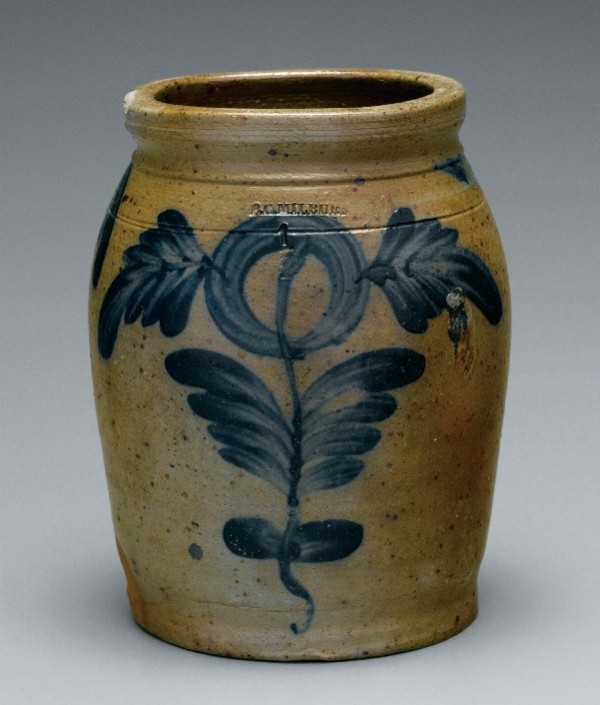
Jar, Alexandria, Virginia, 1847–1861. Salt-glazed stoneware, brushed cobalt. H. 7 1/2". Capacity: Q÷@ gallon. Impressed mark: B.C.MILBURN. (Courtesy, Al Marzorini; photos by Gavin Ashworth unless otherwise noted.) The central round flower is known as the Alexandria motif.

Jar, Alexandria, Virginia, 1847–1851. Salt-glazed stoneware, brushed cobalt. H. 9 1/2". Capacity: 1 gallon. Impressed mark: H.C.SMITH / ALEXA. (Courtesy, Alexandria Archaeology Museum.) Encircling foliage is another common motif on Alexandria stoneware. Brushed-cobalt decoration was common until the Civil War. This piece was found in archaeological excavations on a residential property at 524 King Street.
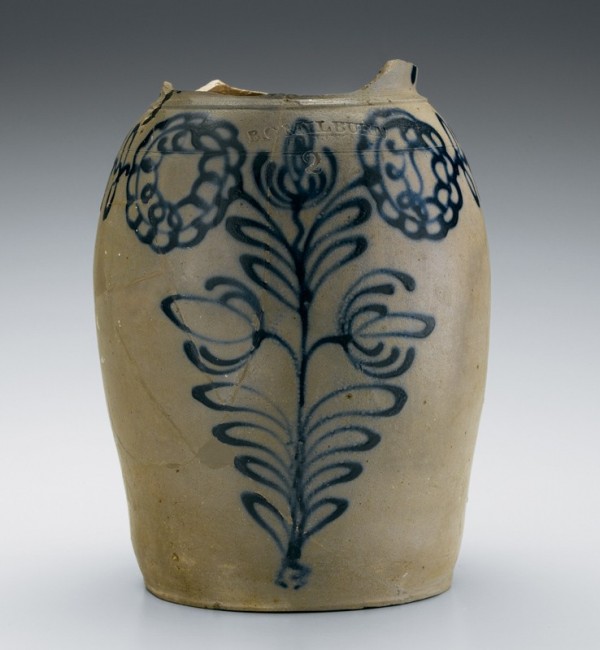
Pitcher, B.C. Milburn, Alexandria, Virginia, 1847–1861. Salt-glazed stoneware, slip-trailed cobalt. H. 11". Capacity: 2 gallons. Impressed mark: B.C.MILBURN / ALEXA. (Courtesy, Alexandria Archaeology Museum.) Slip-trailed cobalt decoration is typical of the later Milburn period. The pitcher was found in a privy at 112 South Royal Street, in the midst of Alexandria’s commercial district.
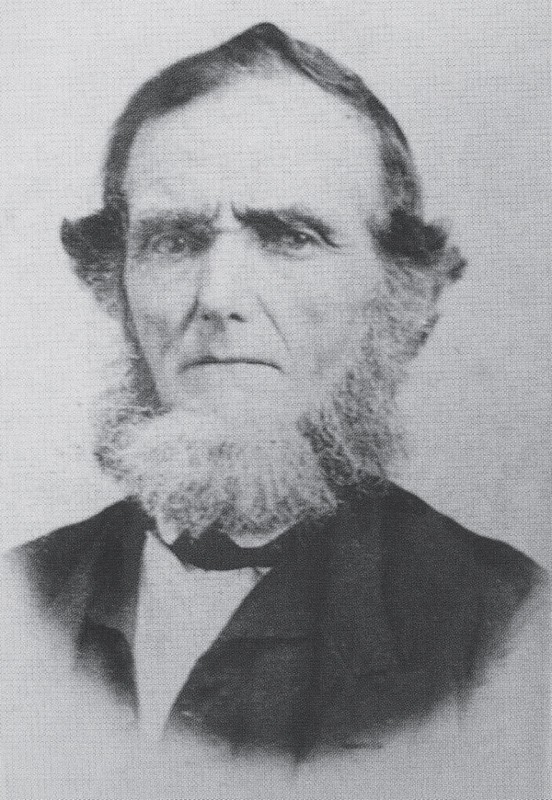
Benedict C. Milburn (1805–1867). (Courtesy, Smithsonian Institution, National Museum of American History.)
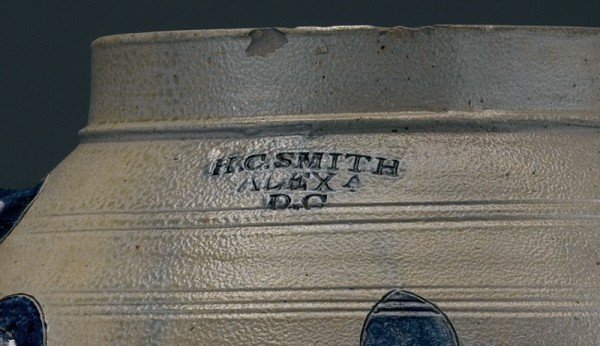
Detail of the “H.C.SMITH / ALEXA. / D.C” mark on the cooler illustrated in fig. 12. Although the stamp is found on many vessels of this period, this is the only known example in which it is highlighted with cobalt.
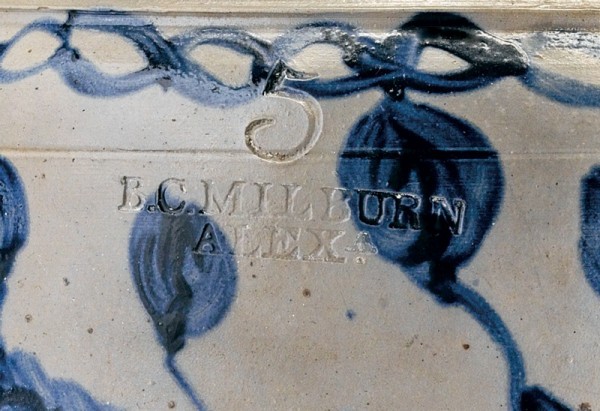
Detail of the cooler illustrated in fig. 68 showing capacity mark with “B.C.MILBURN / ALEXA.” potter’s mark, 1847–1861. Whereas most capacity marks were made with impressed lead type, some 5- and 6-gallon capacity marks were drawn freehand on the leather-hard surface.
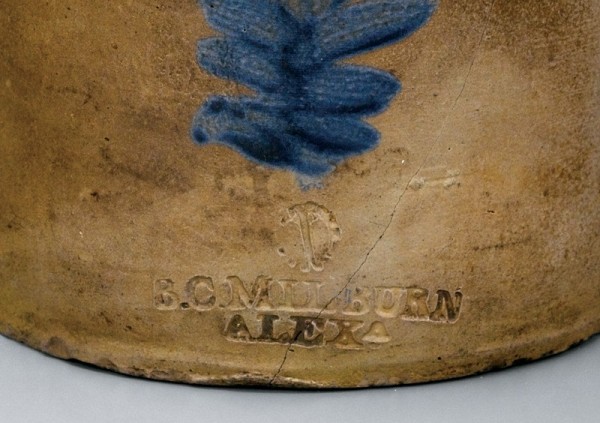
Detail of the cylindrical jar illustrated in fig. 27 showing capacity mark with “B.C.MILBURN / ALEXA.” potter’s mark, 1847–1861. Some of Milburn’s 1- and 1 1/2-gallon capacity marks include a dashed circle, similar to marks used on some of the earliest Swann vessels.
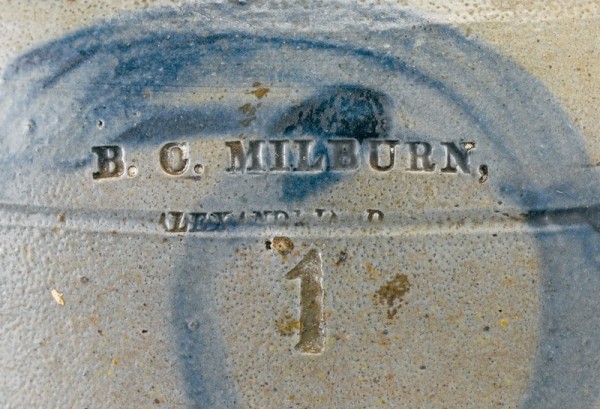
Detail showing the potter’s mark of the cylindrical jar illustrated in fig. 19: “B.C. MILBURN, / ALEXANDRIA D. C.” This is the only mark in which the place name is executed in smaller, italic type. The city’s name is spelled out only on this mark and that made for Dubois & Reddick, illustrated in fig. 17.
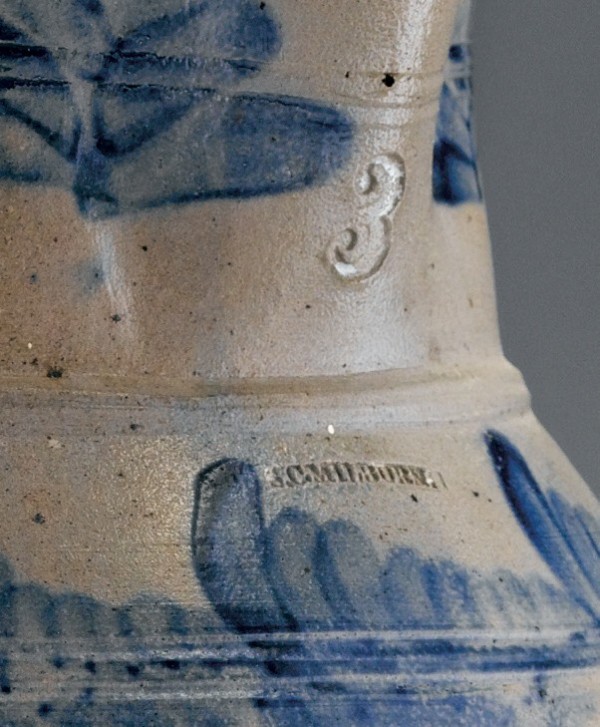
Detail of the pitcher illustrated in fig. 51 showing the “S. C. MILBURN.” potter’s mark. This late mark is usually found on undecorated stoneware.

“W. LEWIS MILBURN.” potter’s mark, 1873–1876. D. of rim 7". Capacity: 1 gallon. (Courtesy, Alexandria Archaeology Museum.) This is the only piece found at the Milburn kiln site with this mark.

Pitcher, Alexandria, Virginia, 1831–1847. Salt-glazed stoneware, brushed cobalt. H. 11". Impressed mark: H.C.SMITH / ALEXA. / D.C (Courtesy, Smithsonian Institution, National Museum of American History.) Brushed cobalt is the most common form of decoration on Alexandria stoneware.
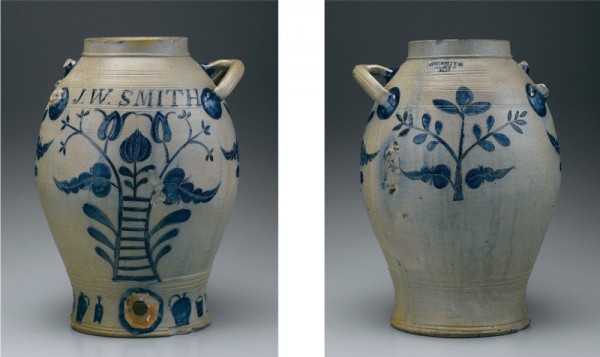
Cooler, Alexandria, Virginia, 1831–1847. Salt-glazed stoneware, incised decoration. H. 18 1/2". Inscribed: J. W. SMITH; impressed mark: H.C.SMITH / ALEXA. / D.C (Courtesy, Smithsonian Institution, National Museum of American History.) This is the only known piece of Alexandria stoneware with incised and cobalt-filled decoration. This unusual cooler appears to have been made for a tavern, with images of bottles and jugs around its base. Leafy branches appear on the reverse and under each handle. 12The most likely owner of this piece was James W. Smith, listed in an 1834 business directory as proprietor of the Globe Tavern on Cameron Street, opposite the Market House.
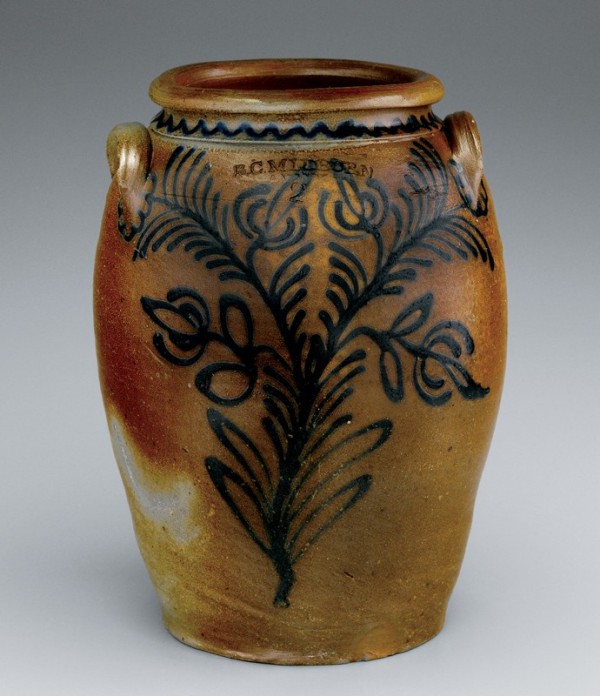
Jar, Alexandria, Virginia, 1847–1861. Salt-glazed stoneware, slip-trailed cobalt. H. 12 1/2". Capacity: 2 gallons. Impressed mark: B.C. MILBURN / ALEXA. (Courtesy, Al Marzorini.) Slip trailing, a technique seen much earlier on Baltimore, New Jersey, and New York stoneware, was not introduced in Alexandria until sometime between 1847 and 1854.

Jar, Alexandria, Virginia, 1847–1867. Salt-glazed stoneware. H. 5". Impressed mark: B C MILBURN (Courtesy, Alexandria Archaeology Museum.) Plain, utilitarian wares were made throughout the history of the Wilkes Street Pottery, but predominated after the Civil War. This jar was found in a privy behind 307 South Saint Asaph Street, an elegant house that was occupied, as were many Alexandria homes, by Union troops during the war.
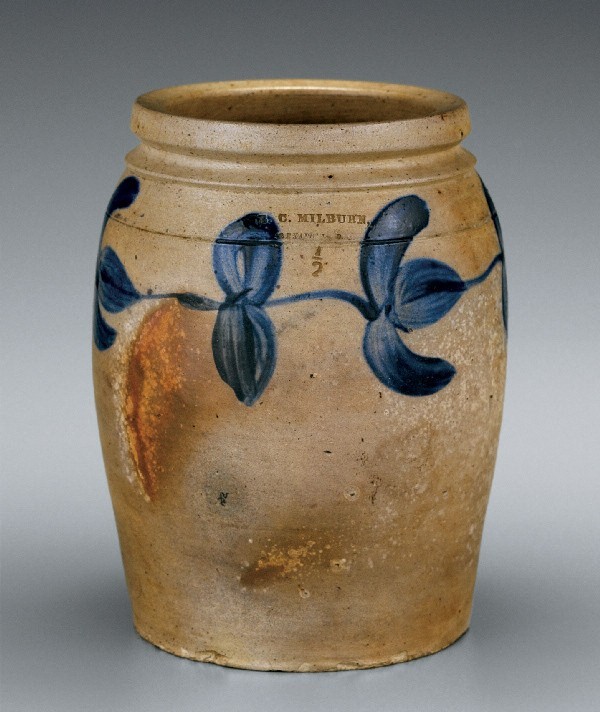
Jar, Alexandria, Virginia, 1841–1847. Salt-glazed stoneware, brushed cobalt. H. 8". Capacity: 1/2 gallon. Impressed mark: B.C. MILBURN, / ALEXANDRIA D. C. (Courtesy, Toby and Oscar Fitzgerald.) Encircling foliage is the most common decorative motif on early Milburn stoneware.

Pitcher, Alexandria, Virginia, 1831–1847. Salt-glazed stoneware, brushed cobalt. H. 15 1/4". Capacity: 3 gallons. Impressed mark: H.C.SMITH / ALEXA. / D.C (Private collection.) The Alexandria motif, consisting of a central round flower on a stem of graduated leaves, was introduced about 1820 by earlier Wilkes Street potter John Swann.
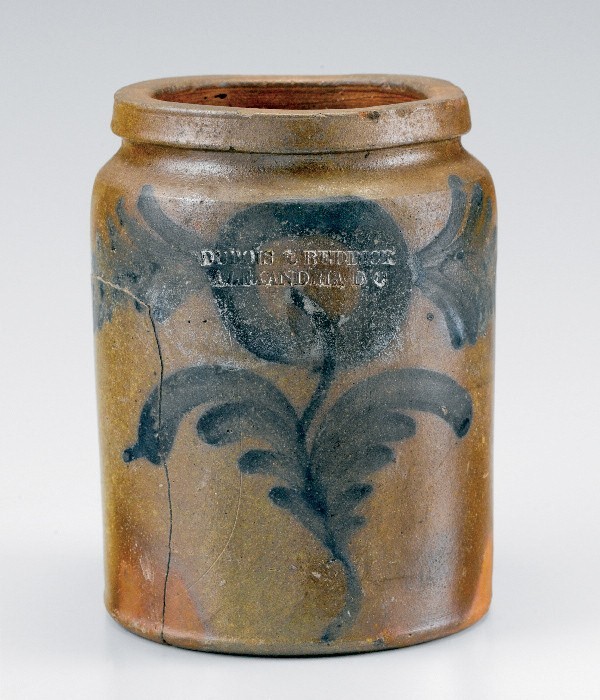
Jar, Alexandria, Virginia, 1841–1847. Salt-glazed stoneware, brushed cobalt. H. 7 1/4". Impressed mark: DUBOIS & REDDICK / ALEXANDRIA D C (Private collection.) This jar, made at Milburn’s pottery for an Alexandria merchant, is the only documented example with this mark.
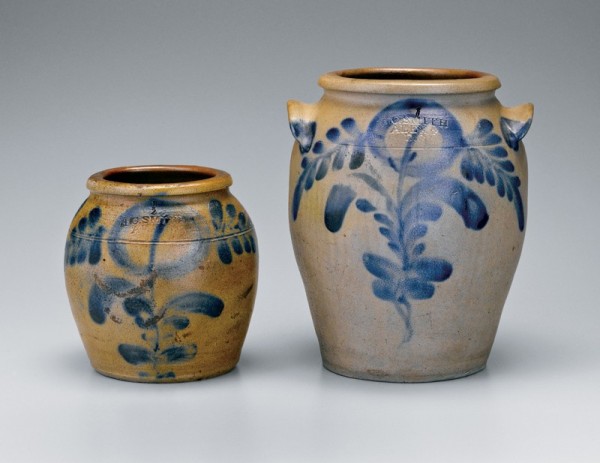
Jars, Alexandria, Virginia, 1831–1847. Salt-glazed stoneware, brushed cobalt. Left: H. 8". Capacity: 1/2 gallon. Right: H. 9 1/2". Capacity: 1 gallon. Impressed mark: H.C.SMITH / ALEXA. / D.C (Private collection.) A modification of the Alexandria motif introduced on early Milburn stoneware includes pairs of longer, straight leaves near the base of the leafy stems.
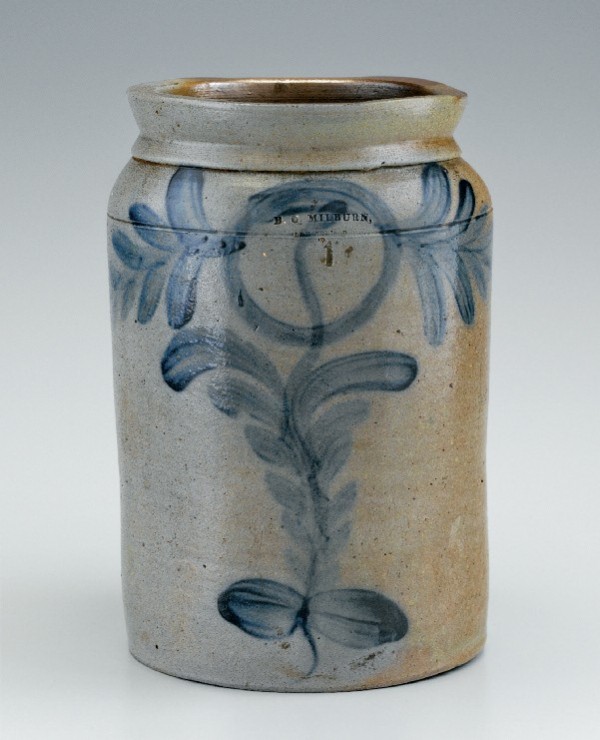
Jar, Alexandria, Virginia, 1841–1847. Salt-glazed stoneware, brushed cobalt. H. 9 1/2". Capacity: 1 gallon. Impressed mark: B.C. MILBURN, / ALEXANDRIA D. C. (Private collection.)
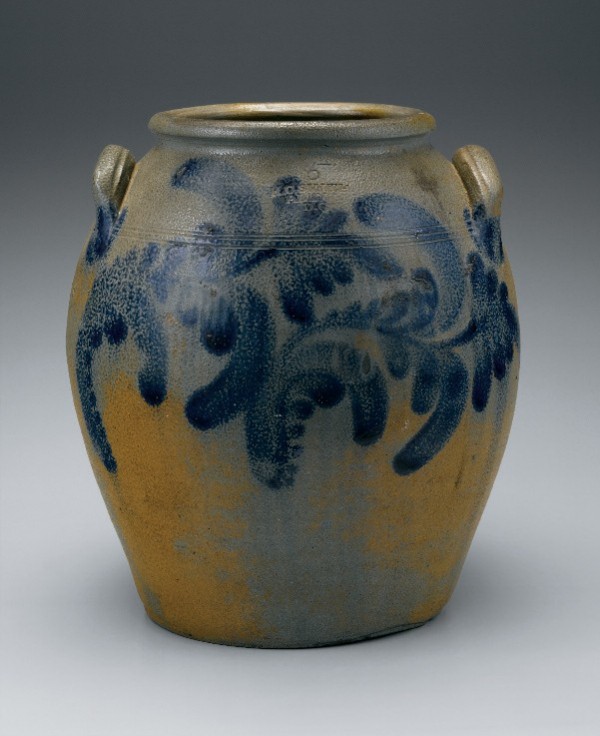
Jar, Alexandria, Virginia, 1831–1847. Salt-glazed stoneware, brushed cobalt. H. 15". Impressed mark: H.C.SMITH / ALEXA. / D.C (Courtesy, The Lyceum: Alexandria’s History Museum.) The thick leafy stem, found with both of the H. C. Smith marks, appears to be the work of one decorator. The more crowded, encircling foliage seen here is only on jars from the early Milburn period.

Milk pan, Alexandria, Virginia, 1831–1847. Salt-glazed stoneware, brushed cobalt. D. 10". Capacity: 1 gallon. Impressed mark: H.C.SMITH / ALEXA. / D.C (Courtesy, Alexandria Archaeology Museum.) A design of pendant leafy fronds, sometimes called “swag and tassel,” first appeared with this mark. It is more common on the back of Alexandria stoneware, but on this piece, separate, shorter fronds appear on the reverse. The milk pan was discarded in a privy at 106 South Saint Asaph Street in the latter half of the nineteenth century.

Jar, Alexandria, Virginia, 1847–1861. Salt-glazed stoneware, brushed cobalt. H. 14 1/4". Capacity: 5 gallons. Impressed mark: B.C.MILBURN / ALEXA. (Courtesy, Al Marzorini.) Brushed and slip-trailed designs were used concurrently, and similar designs were executed with both techniques.
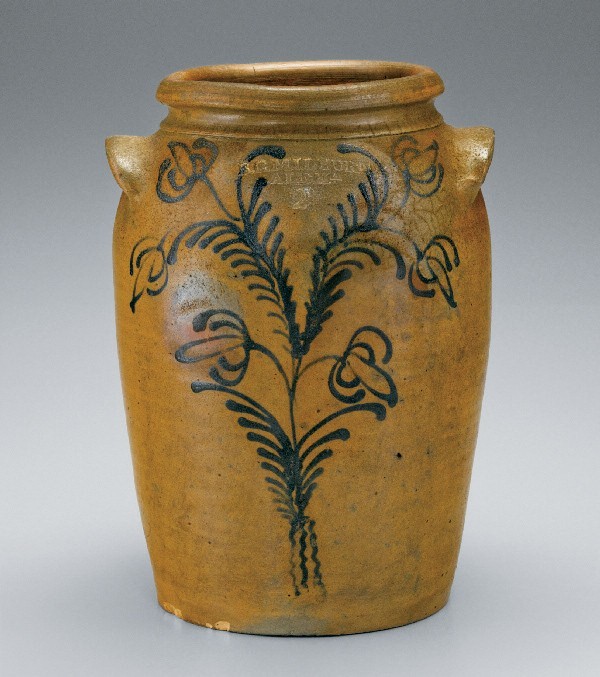
Jar, Alexandria, Virginia, 1847–1861. Salt-glazed stoneware, slip-trailed cobalt. Dimensions not provided. Capacity: 2 gallons. Impressed mark: B.C.MILBURN / ALEXA. (Private collection.)

Jar, Alexandria, Virginia, 1847–1861. Salt-glazed stoneware, brushed cobalt. H. 9 1/2". Capacity: 1 gallon. Impressed mark: B.C.MILBURN / ALEXA. (Private collection.) Chains and pendant flowers encircle this jar. Similar designs were also executed in slip-trailed cobalt.
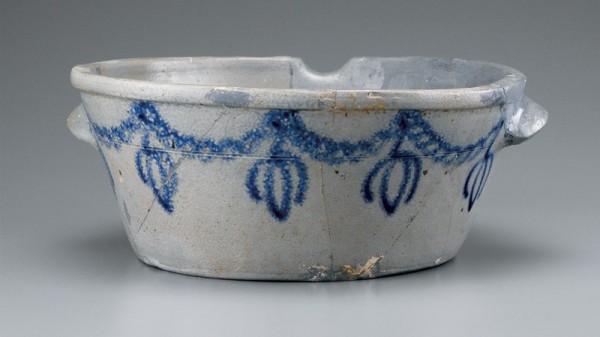
Milk pan, Alexandria, Virginia, 1847–1861. Salt-glazed stoneware, slip-trailed cobalt. D. 11 1/4". Impressed mark: B.C.MILBURN / ALEXA. (Courtesy, Alexandria Archaeology Museum.) Chains and pendant flowers are more commonly seen on the back of vessels, as on this milk pan found in an excavation at 112 South Royal Street.
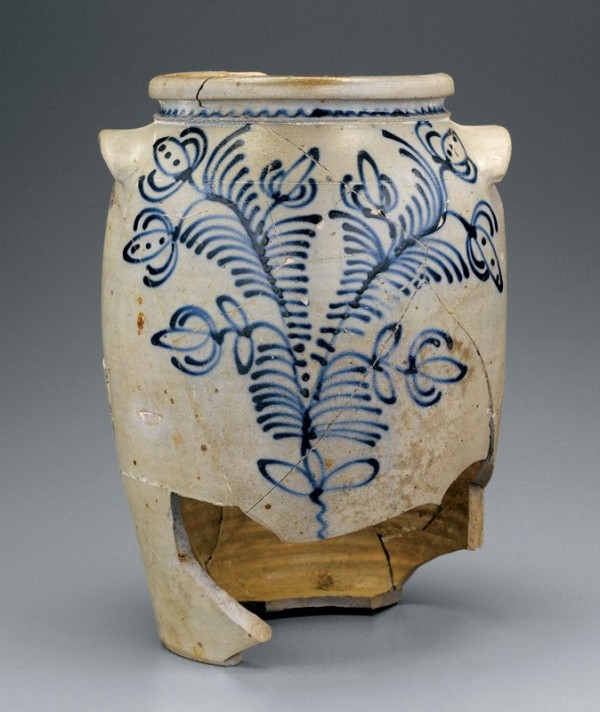
Jar, Alexandria, Virginia, 1847–1861. Salt-glazed stoneware, slip-trailed cobalt. H. 14 1/2". Capacity: 4 gallons. Impressed mark: B.C.MILBURN / ALEXA. (Courtesy, Alexandria Archaeology Museum.) This elaborately decorated jar was found in excavations at Alfred and South Columbus streets, in a nineteenth-century free black neighborhood.
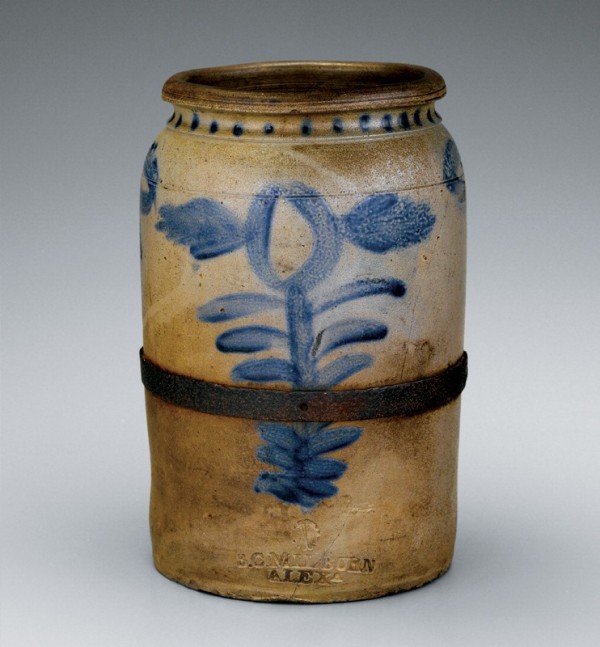
Jar, Alexandria, Virginia, 1847–1861. Salt-glazed stoneware, brushed cobalt. H. 10 1/2". Capacity: 1 gallon. Impressed mark: B.C.MILBURN / ALEXA. (Courtesy, Al Marzorini.) This jar has a very primitive version of the central round flower. Large chain links with pendant branches appear on the reverse. The iron band is an old “make do” repair, probably from the nineteenth century.
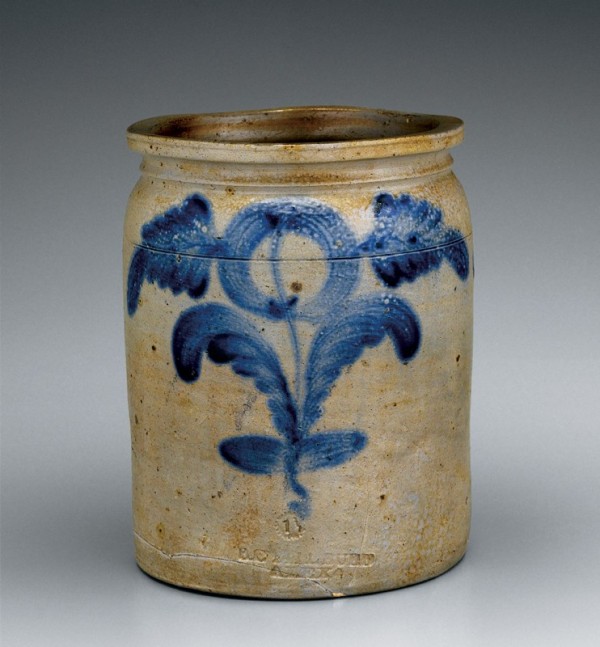
Jar, Alexandria, Virginia, 1847–1861. Salt-glazed stoneware, brushed cobalt. H. 9 1/2". Capacity: 1 1/2 gallons. Impressed mark: B.C.MILBURN / ALEXA. (Courtesy, Al Marzorini.) This mark was documented on nearly one hundred vessels, split evenly between those with brushed and slip-trailed designs. The Alexandria motif is the most common design on later Milburn stoneware.

Milk pan, Alexandria, Virginia, 1847–1861. Salt-glazed stoneware, brushed cobalt. D. 9". Capacity: 1 1/2 gallons. Impressed mark: B.C. MILBURN. (Courtesy, Alan Darby.) Vessels with this mark have similar form and decoration as those stamped “B.C. MILBURN / ALEXA.”
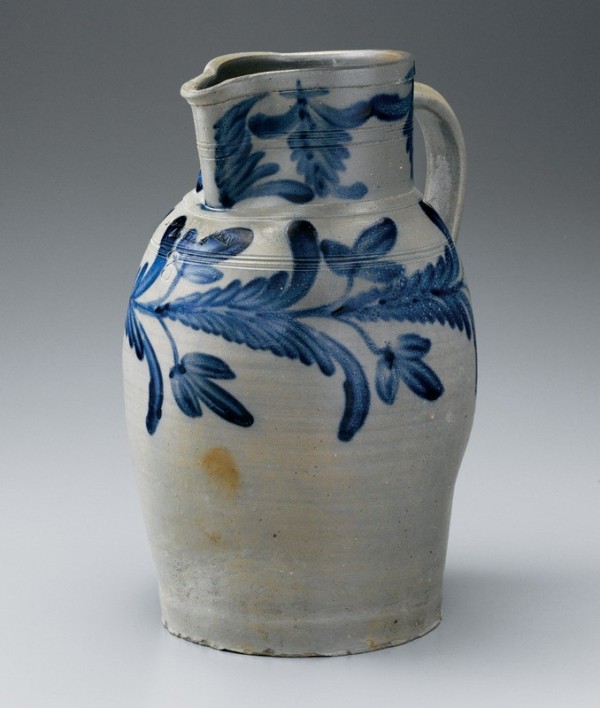
Pitcher, Alexandria, Virginia, 1847–1861. Salt-glazed stoneware, brushed cobalt. H. 14 3/4". Capacity: 3 gallons. Impressed mark: B.C.MILBURN / ALEXA. (Courtesy, Alan Darby.) Encircling foliage remains popular in the later Milburn period.
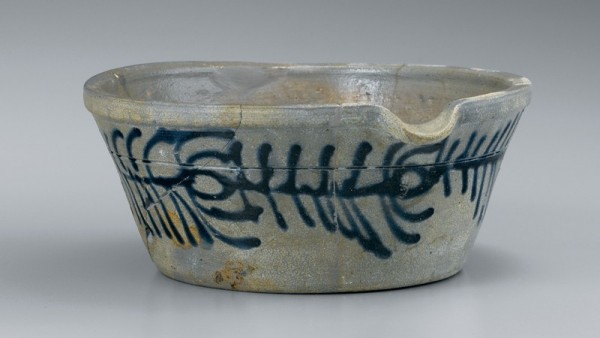
Milk pan, Alexandria, Virginia, 1847–1861. Salt-glazed stoneware, slip-trailed cobalt. D. 8". Capacity: 1/2 gallon. Impressed mark: B.C.MILBURN / ALEXA. (Courtesy, Alexandria Archaeology Museum.) Encircling foliage is also common in slip-trailed designs. This milk pan was found in excavations on the 400 block of King Street, Alexandria’s main commercial district.
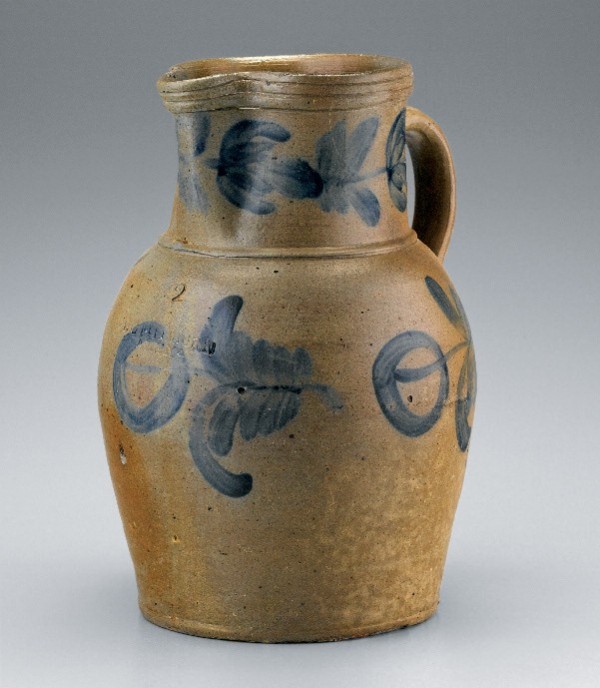
Pitcher, Alexandria, Virginia, 1847–1861. Salt-glazed stoneware, brushed cobalt. H. 13 1/4". Capacity: 3 gallons. Impressed mark: B.C.MILBURN / ALEXA. (Private collection.) A sideways version of the round flower first appears in the later Milburn period, and is more commonly found on the back of vessels.

Jar, Alexandria, Virginia, 1847–1861. Salt-glazed stoneware, brushed cobalt. H. 9". Capacity: 1 gallon. Impressed mark: B.C.MILBURN / ALEXA. (Private collection.) The round flower is dotted to represent seeds.

Jar, Alexandria, Virginia, 1847–1861. Salt-glazed stoneware, brushed cobalt. H. 10 1/2". Capacity: 1 gallon. Impressed mark: B.C.MILBURN / ALEXA. (Courtesy, Al Marzorini.) The sunflower was first depicted by Swann but was not used on early Milburn stoneware.
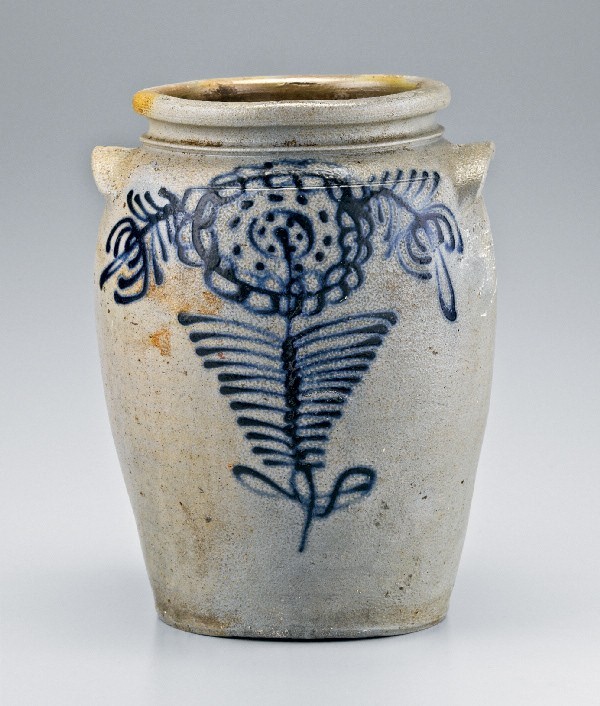
Jar, Alexandria, Virginia, 1847–1861. Salt-glazed stoneware, slip-trailed cobalt. H. 12". Capacity: 2 gallons. Impressed mark: B.C.MILBURN / ALEXA. (Private collection.) This design includes a sunflower with seeds and petals, flanked by tulips.

Jars, Alexandria, Virginia, 1847–1861. Salt-glazed stoneware, brushed cobalt. Left: H. 10 3/4". Capacity: 1 1/2 gallons. Right: H. 11". Capacity: 2 gallons. Impressed mark: B.C. MILBURN. (Courtesy, Al Marzorini.) This flower, with petals within a circle, appears for the first time with this mark.

Jar, Alexandria, Virginia, 1847–1861. Salt-glazed stoneware, slip-trailed cobalt. H. 12". Capacity: 1 1/2 gallons. Impressed mark: B.C.MILBURN / ALEXA. (Courtesy, Al Marzorini.) The decorator combined two common elements in slip-trailed cobalt, the sunflower and the tulip.
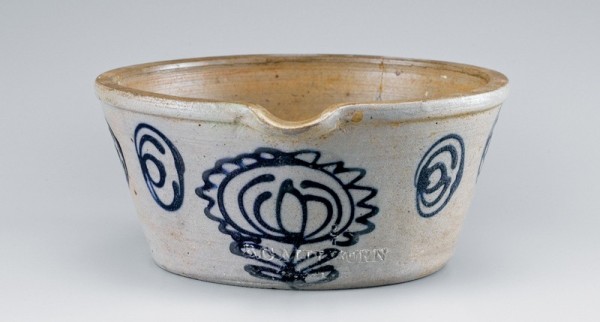
Milk pan, Alexandria, Virginia, 1847–1861. Salt-glazed stoneware, slip-trailed cobalt. D. 8". Capacity: 1/2 gallon. Impressed mark: B.C.MILBURN / ALEXA. (Private collection.)

Jar, Alexandria, Virginia, 1847–1861. Salt-glazed stoneware, slip-trailed cobalt. H. 12 1/2". Capacity: 2 gallons. Impressed mark: B.C.MILBURN / ALEXA. (Courtesy, Al Marzorini.) Tulips sprout from the edges of a large sunflower. The seeds are made up of a series of chain links.
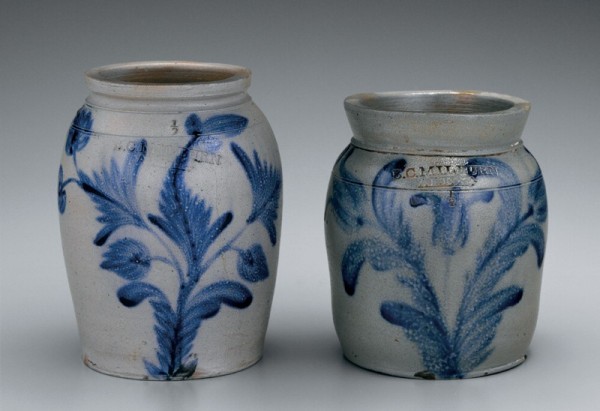
Jars, Alexandria, Virginia, 1847–1861. Salt-glazed stoneware, brushed cobalt. H. 8 1/4" and 7". Capacity: 1/2 gallon. Impressed mark: B.C.MILBURN / ALEXA. [on both]. (Courtesy, Toby and Oscar Fitzgerald.) Tulips, first used by Swann, are more common in the later Milburn period.

Jar, attributed to B.C. Milburn, Alexandria, Virginia, 1847–1861. Salt-glazed stoneware, brushed cobalt. H. 9 1/4". Capacity: 1 gallon. (Courtesy, Alexandria Archaeology Museum.) Unlike most of the decorated vessels from the Wilkes Street Pottery, this jar is not marked. The tulip was commonly used as the central flower on vessels with the “B.C.MILBURN / ALEXA.” mark, and the primitive brushwork matches other vessels from this period. The jar was found in archaeological excavations on Alexandria’s Market Square.

Jars, Alexandria, Virginia, 1847–1861. Salt-glazed stoneware, slip-trailed cobalt. Left: H. 10 1/4". Capacity: 1 gallon. Center: H. 11". Capacity: 1 1/2 gallons. Right: H. 12 1/2". Capacity: 2 gallons. Impressed mark: B.C.MILBURN / ALEXA. (Private collection.) Milburn employed several decorators, who executed similar motifs in their own style.

Jar, Alexandria, Virginia, 1847–1861. Salt-glazed stoneware, slip-trailed cobalt. H. 15 3/4". Capacity: 4 gallons. Impressed mark: B.C.MILBURN / ALEXA. (Courtesy, John and Lil Palmer.) The tulip motif is also used with encircling foliage.
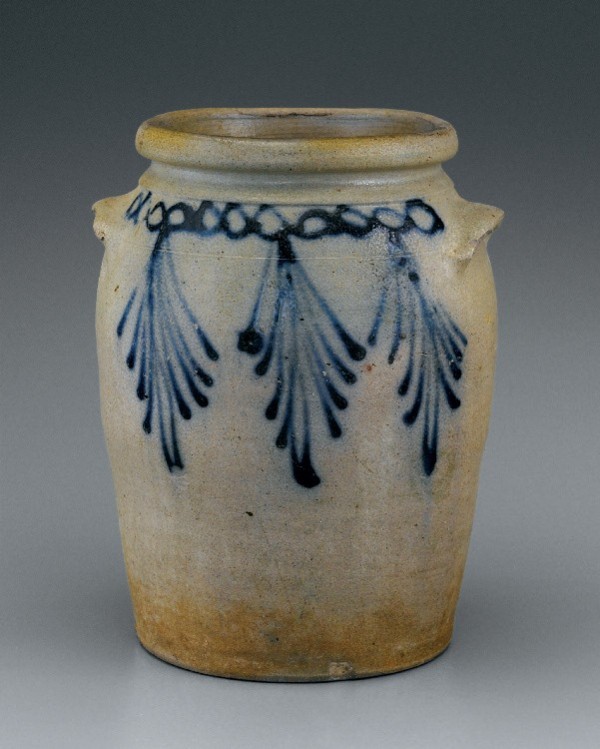
Jar, Alexandria, Virginia, 1847–1861. Salt-glazed stoneware, slip-trailed cobalt. H. 10 1/2". Capacity: 1 1/2 gallons. Impressed mark: B.C.MILBURN / ALEXA. (Courtesy, William and Jane Yeingst.) In the later Milburn period, pendant leafy fronds were usually combined with chains instead of plain swags. The reverse is decorated with two sideways tulip-like flowers.

Milk pan, Alexandria, Virginia, 1847–1861. Salt-glazed stoneware, slip-trailed cobalt. D. 12". Capacity: 1 gallon. Impressed mark: B.C.MILBURN / ALEXA. (Courtesy, Alexandria Archaeology Museum.) The chains and pendant flowers continue on the reverse. This milk pan was found in excavations at 112 South Royal Street.
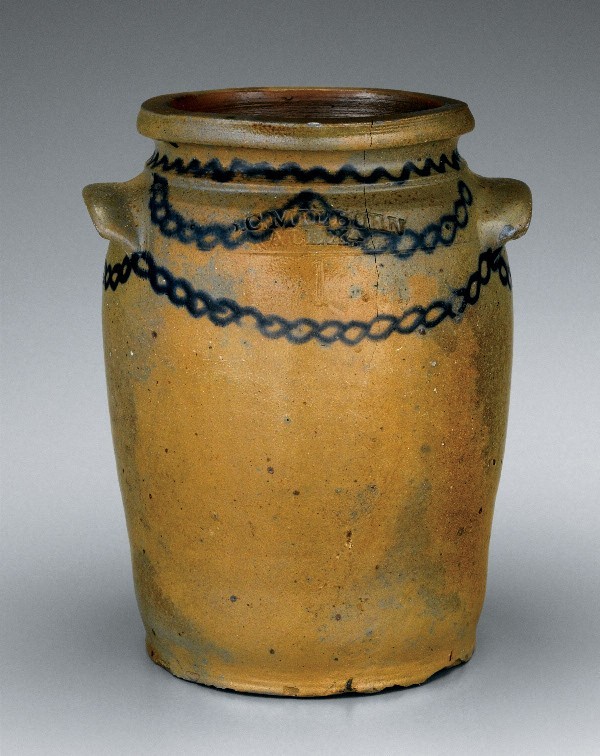
Jar, Alexandria, Virginia, 1847–1861. Salt-glazed stoneware, slip-trailed cobalt. H. 10". Capacity: 1 gallon: Impressed mark: B.C.MILBURN / ALEXA. (Courtesy, Al Marzorini.) Chains or wavy lines usually appear on the reverse of Milburn’s vessels, but they decorate both sides of this jar.
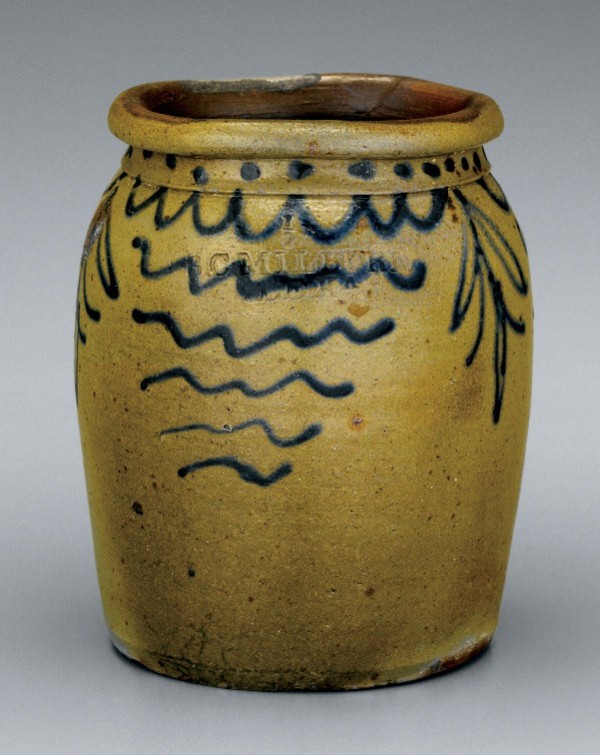
Jar, Alexandria, Virginia, 1847–1861. Salt-glazed stoneware, slip-trailed cobalt. H. 7 1/2". Capacity: 1/2 gallon. Impressed mark: B.C.MILBURN / ALEXA. (Courtesy, John and Lil Palmer.) A similar pattern of dots and wavy lines appears on the reverse of this jar, with the front and back separated by pendant fronds.

Jar, Alexandria, Virginia, 1847–1861. Salt-glazed stoneware, brushed cobalt. H. 8". Capacity: 1/2 gallon. Impressed mark: B.C.MILBURN / ALEXA. (Private collection.) The graduated foliage at the shoulder is similar to that used by Shenandoah Valley potters.
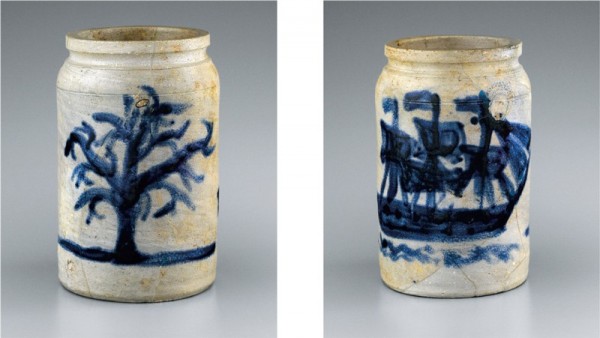
Jar, attributed to B.C. Milburn, Alexandria, Virginia, 1847–1861. Salt-glazed stoneware, brushed cobalt. H. 8 1/4". (Courtesy, Alexandria Archaeology Museum.) The representative subject matter is unusual, but the clay, the shape of the vessel, and the use of slip trailing are similar to other Milburn pieces. This jar was found in excavations in Alexandria, at the site of a nineteenth-century restaurant and residence on the 400 block of King Street.
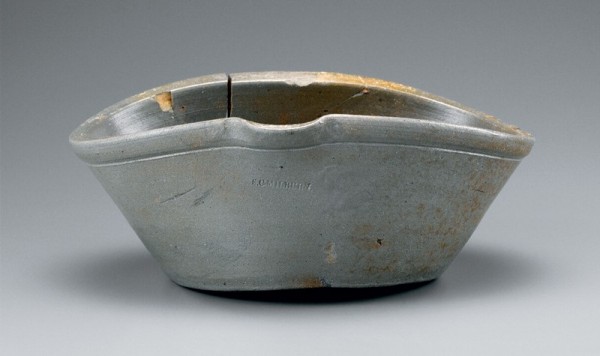
Milk pan, Alexandria, Virginia, 1867–1873. Salt-glazed stoneware. H. 4 1/2". Impressed mark: S.C.MILBURN. (Courtesy, Alexandria Archaeology Museum.) Despite the crack, this badly warped “second” was used at a residence at 307 South Saint Asaph Street.

Pitcher, Alexandria, Virginia, 1867–1873. Salt-glazed stoneware, brushed cobalt. H. 15 3/4". Capacity: 3 gallons. Impressed mark: S.C.MILBURN. (Private collection.) This is a rare example of a decorated S. C. Milburn vessel.

Jars and bowl, Alexandria, Virginia. Salt-glazed stoneware. Jar, back left, 1865–1876. H. 13 1/4". Impressed mark: E.J.MILLER / ALEXA.. Jar, back right, 1847–1867. H. 9 1/2". Impressed mark: B.C.MILBURN / ALEXA.. (Courtesy, The Lyceum: Alexandria’s History Museum.) Bowl, front, 1865–1876. D. 10". Impressed mark: E.J.MILLER / ALEXA. (Courtesy, Smithsonian Institution, National Museum of American History.) E. J. Miller took over his father’s china shop in 1865, and jars with his mark are identical to ones with the marks of B.C. and S.C. Milburn. Five sherds marked E. J. Miller were found at the Milburn kiln site.
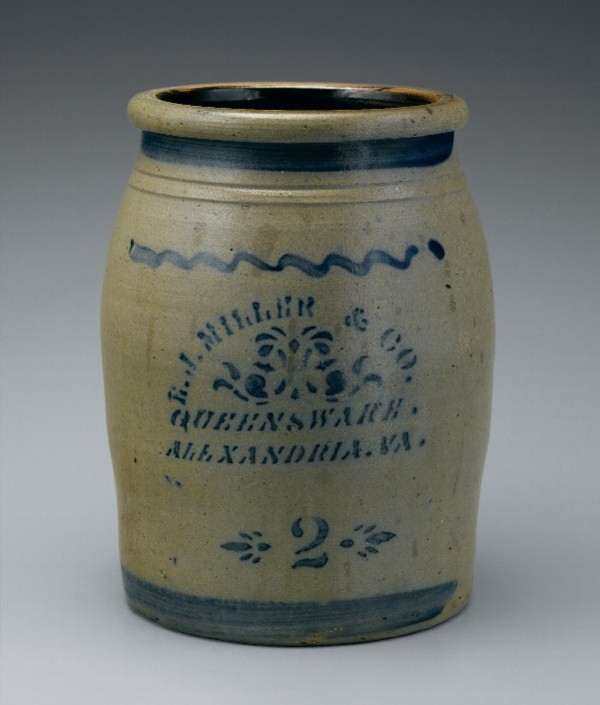
Jar, James Hamilton, Greensboro, Pennsylvania, after ca. 1876. Salt-glazed stoneware with Albany-slip interior, brushed and stenciled cobalt. H. 11 1/2". Capacity: 2 gallons. Stenciling: E.J.MILLER & CO. / QUEENSWARE. / ALEXADNRIA.VA. (Courtesy, The Lyceum: Alexandria’s History Museum.) Stenciled advertising is not found on stoneware manufactured in Alexandria. After the Alexandria Pottery closed, E. J. Miller & Co. purchased stoneware from this large Pennsylvania manufactory.

Lug handle. L. 4". Detail of 1819–1821 jar bearing “J.SWANN / ALEXA.” mark. A simple, straight handle with cut ends was first used by John Swann and continued to be used on jars, churns, cake pots, and milk pans throughout the history of the Wilkes Street Pottery.
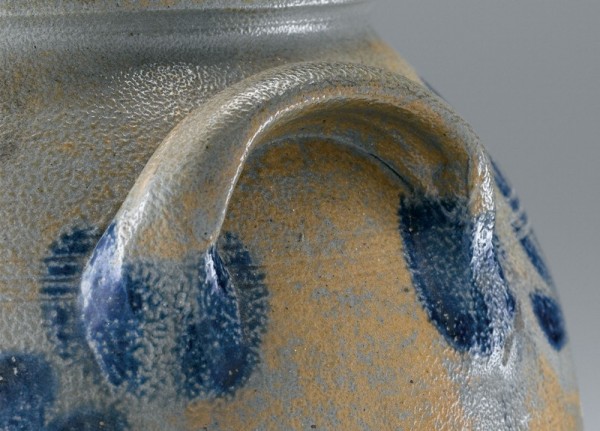
Extruded lug handle. L. 5". Detail of the jar illustrated in fig. 20. Extruded handles, in which clay was forced through a template, first appeared on Alexandria jars between 1831 and 1847; they became common on American stoneware in the mid-nineteenth century.
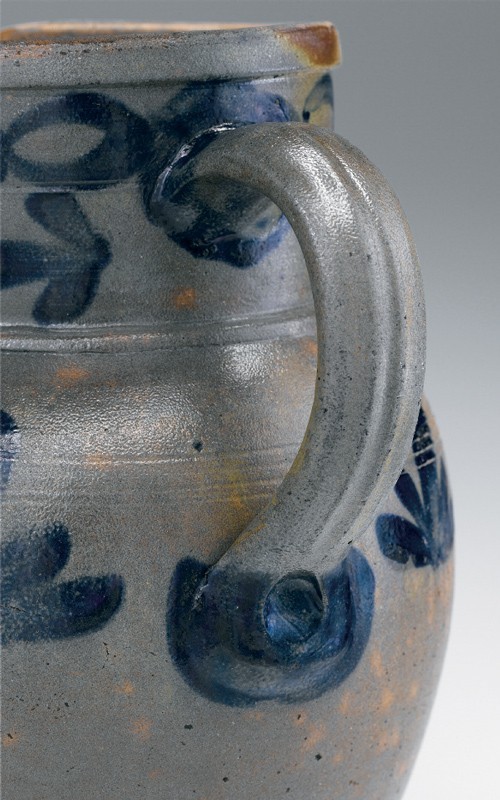
Strap handle. L. 5 1/2". Detail of the pitcher illustrated in fig. 11. Vertical strap handles were used on pitchers, chamber pots, and coolers of all periods.
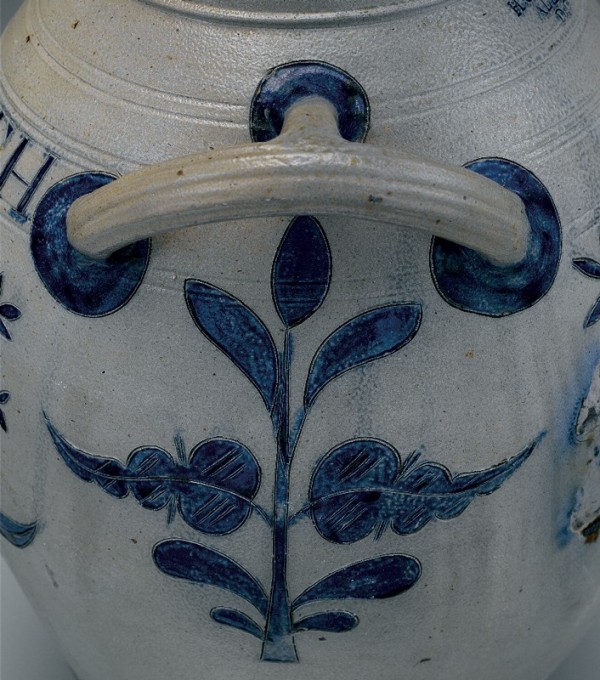
Extruded horizontal open-loop handle. L. 7". Detail of the cooler illustrated in fig. 12.

Lid, Alexandria, Virginia, 1825–1861. Salt-glazed stoneware, brushed cobalt. D. 7 1/2". (Courtesy, Alexandria Archaeology Museum.) Some lids are flat on the underside, but others, like this lid from excavations at 524 King Street, have a shallow flange one inch from the edge.
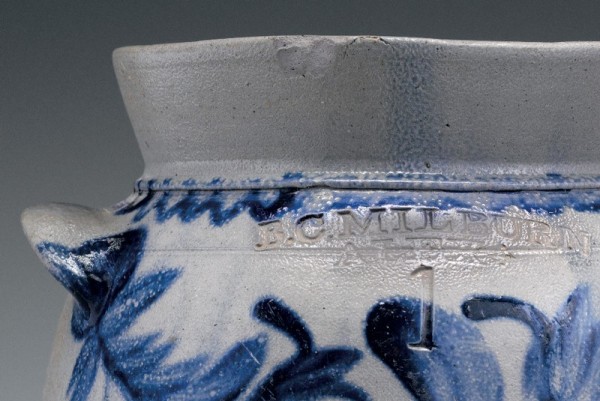
Flared rim. Detail of the jar illustrated in fig. 73. Flared rims accommodated flat stoneware or wooden lids.

Flat rim. Detail of the butter pot illustrated in fig. 64. Flat rims supported a flanged lid, as shown in fig. 58.
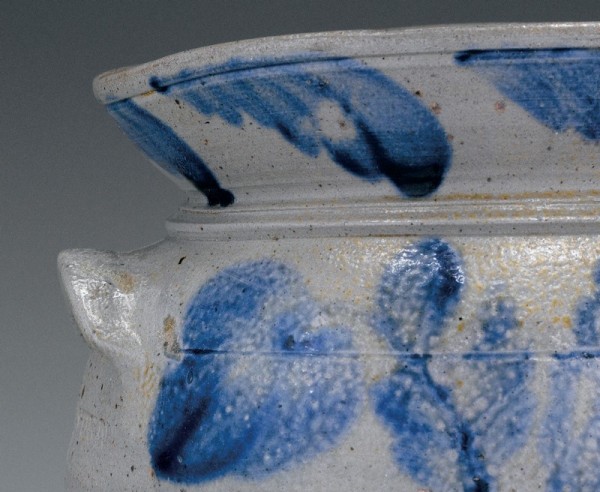
Flared rim. Detail of the churn illustrated in fig. 66. Tall, flared churn rims allow a flat wooden or stoneware disk with a hole for the dasher to sit down inside the rim.
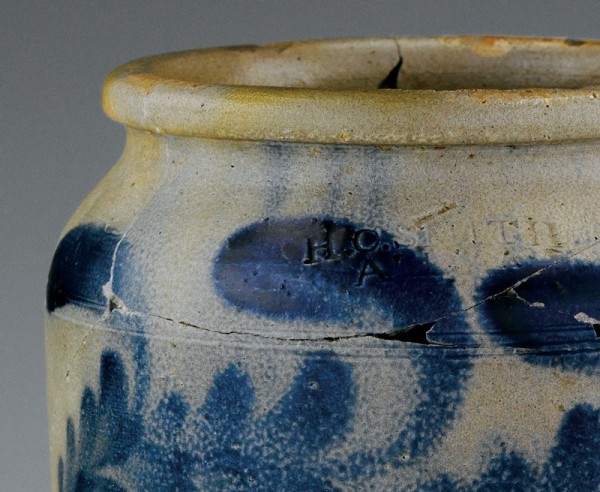
Round rim. Detail of the jar illustrated in fig. 2. The round rim was used on jars throughout the history of the pottery.
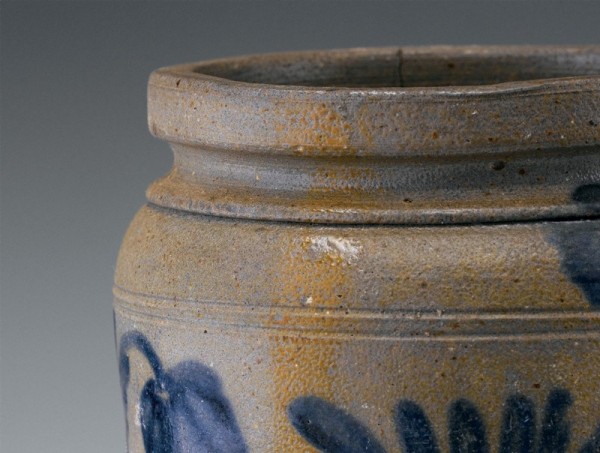
Collared rim. (Detail; jar not illustrated.) (Courtesy, William and Jane Yeingst.) A collar below the rim was first used with the stamp “H. C. SMITH / ALEXA. / D. C” between 1831 and 1847.
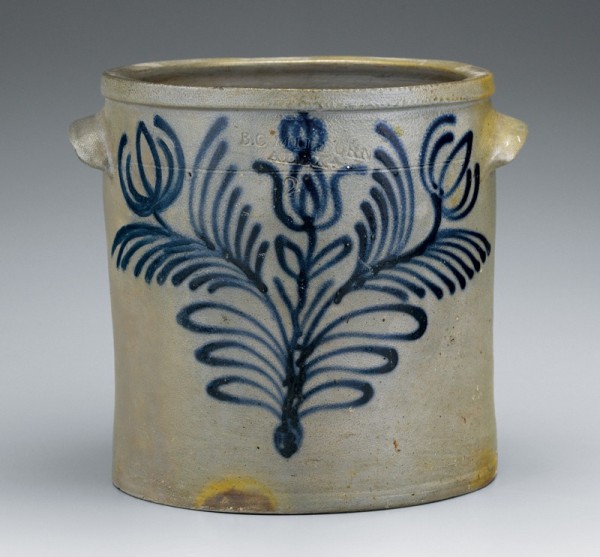
Butter pot, Alexandria, Virginia, 1847–1861. Salt-glazed stoneware, slip-trailed cobalt. H. 9 1/2". Capacity: 2 gallons. Impressed mark: B.C.MILBURN / ALEXA. (Courtesy, Alan Darby.) Milburn’s 1859 trade card lists “butter jars” as covered wares. These would have had flat lids like that shown in fig. 58.
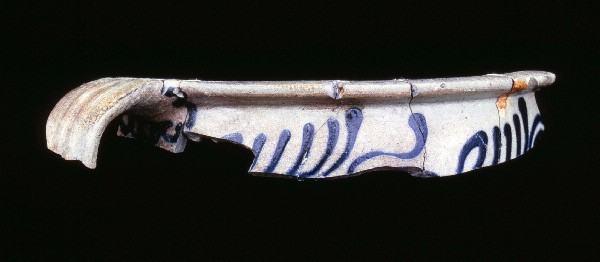
Chamber pot fragment, Alexandria, Virginia, 1847–1861. Salt-glazed stoneware, slip-trailed cobalt. D. 7". (Courtesy, Alexandria Archaeology Museum.) This fragment, found in excavations on the 200 block of North Union Street, is attributed to Milburn based on the familiar slip-trailed design.
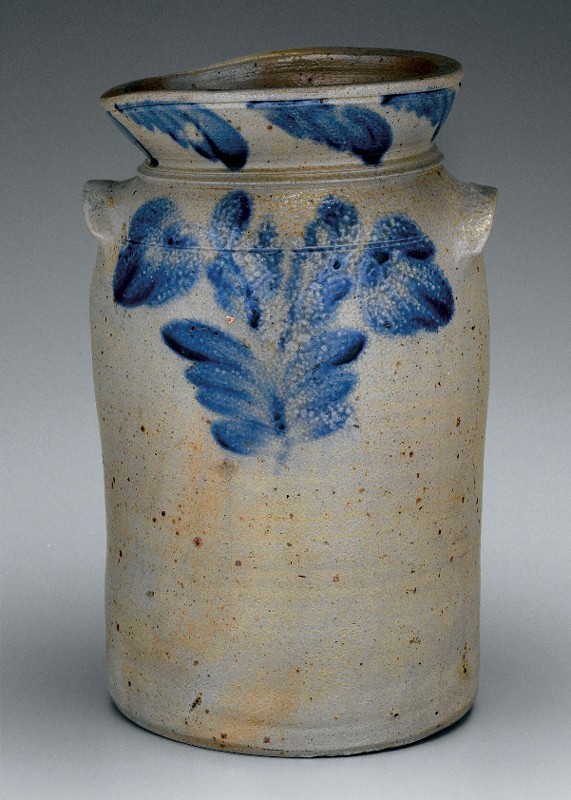
Churn, Alexandria, Virginia, 1847–1861. Salt-glazed stoneware, brushed cobalt. H. 12". Capacity: 2 gallons. Impressed mark: B.C.MILBURN / ALEXA. (Courtesy, John and Lil Palmer.)
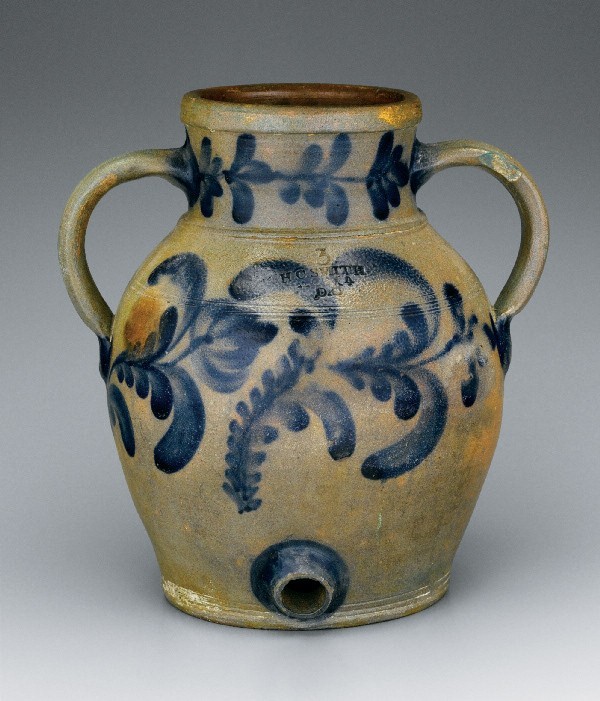
Cooler, Alexandria, Virginia, 1831–1847. Salt-glazed stoneware, brushed cobalt. H. 14". Capacity: 3 gallons. Impressed mark: H.C.SMITH / ALEXA. / D.C (Courtesy, John and Lil Palmer.) The design and shape of this cooler are similar to pitchers of this period, but with two handles and a bunghole at the base instead of a pouring spout at the rim. On the reverse is a large chain on the neck and five-leaf clusters on the shoulder.
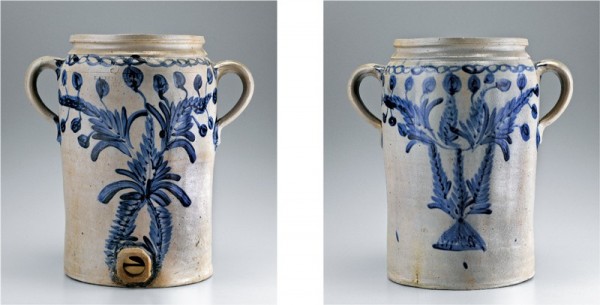
Cooler, Alexandria, Virginia, 1847–1861. Salt-glazed stoneware, brushed cobalt. H. 17". Capacity: 5 gallons. Impressed mark: B.C.MILBURN / ALEXA. (Private collection.) The round flower buds are unusual in Alexandria but similar to ones on jugs attributed to Emanuel Suter (ca. 1866–1880), a later Rockingham County, Virginia, potter.
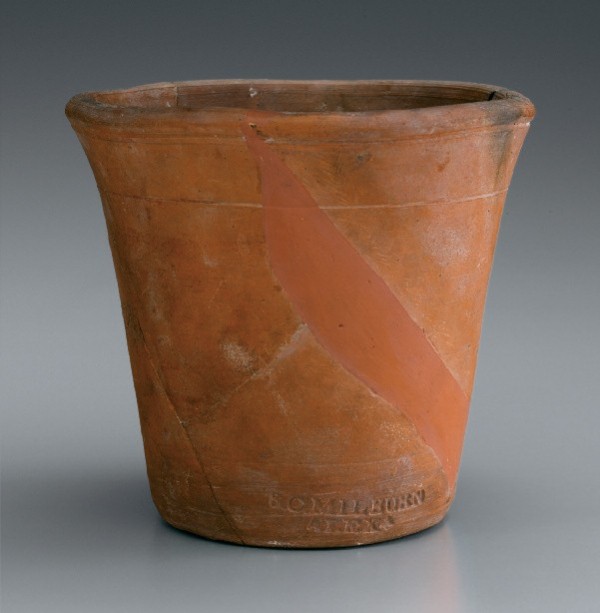
Flowerpot, Alexandria, Virginia, 1841–1867. H. 7 1/4". Salt-glazed stoneware. Stamped near base: B.C.MILBURN / ALEXA. (Courtesy, Alexandria Archaeology Museum.)
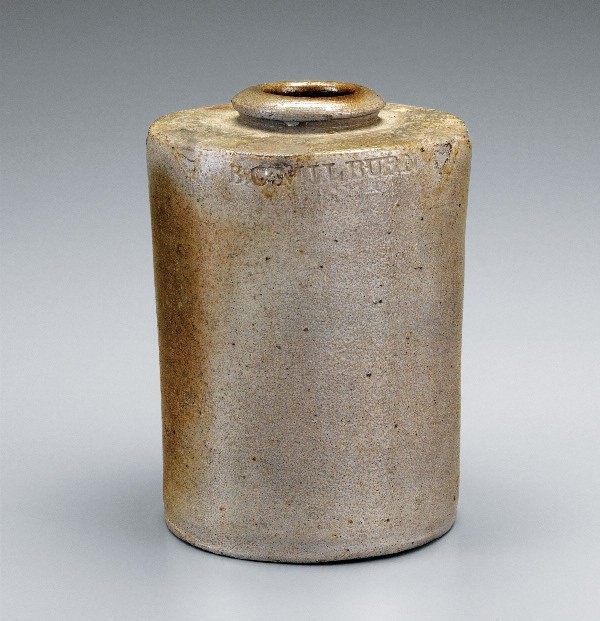
Master ink bottle, Alexandria, Virginia, 1847–1867. Salt-glazed stoneware. H. 6 3/4". Impressed mark: B.C.MILBURN / ALEXA. (Courtesy, Alan Darby.)

Ovoid jars, Alexandria, Virginia, 1831–1847. Salt-glazed stoneware, brushed cobalt. Left: H. 9". Capacity: 1 gallon. Impressed mark: H.C.SMITH / ALEXA. / D.C (Courtesy, The Lyceum: Alexandria’s History Museum.) Right: H. 9 1/2". Capacity: 1 gallon. Impressed mark: H.C.SMITH / ALEXA. (Courtesy, Smithsonian Institution, National Museum of American History.)
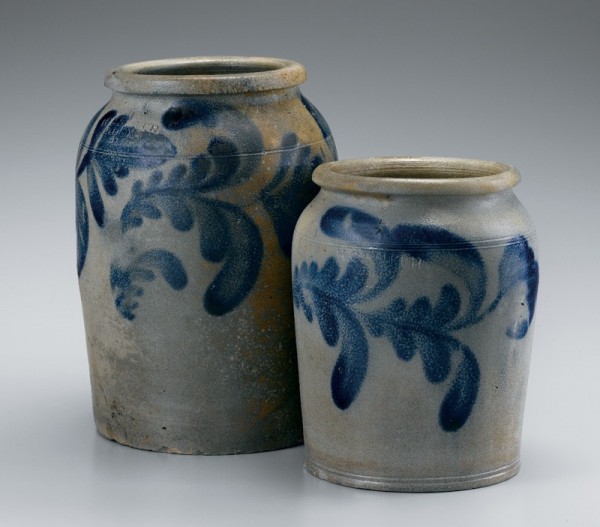
Straight-sided jars, Alexandria, Virginia, 1831–1847. Salt-glazed stoneware, brushed cobalt. Left: H. 10". Capacity: 1 gallon. (Courtesy, The Lyceum: Alexandria’s History Museum.). Right: H. 8". Capacity: 1/2 gallon. Impressed mark: H.C.SMITH / ALEXA. / D.C (Courtesy, Smithsonian Institution, National Museum of American History.) Jars with rounded rims are not quite true cylinders, with sloping shoulders and a narrower rim. This form was first made by John Swann.
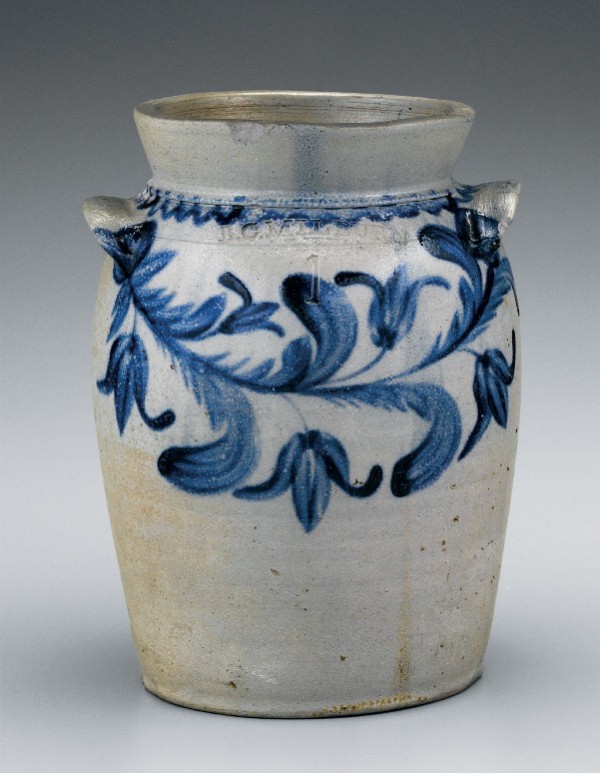
Lidded jar with flared rim, Alexandria, Virginia, 1847–1861. Salt-glazed stoneware, brushed cobalt. H. 9 1/2". Capacity: 1 gallon. Impressed mark: B.C.MILBURN / ALEXA. (Courtesy, Alan Darby.)
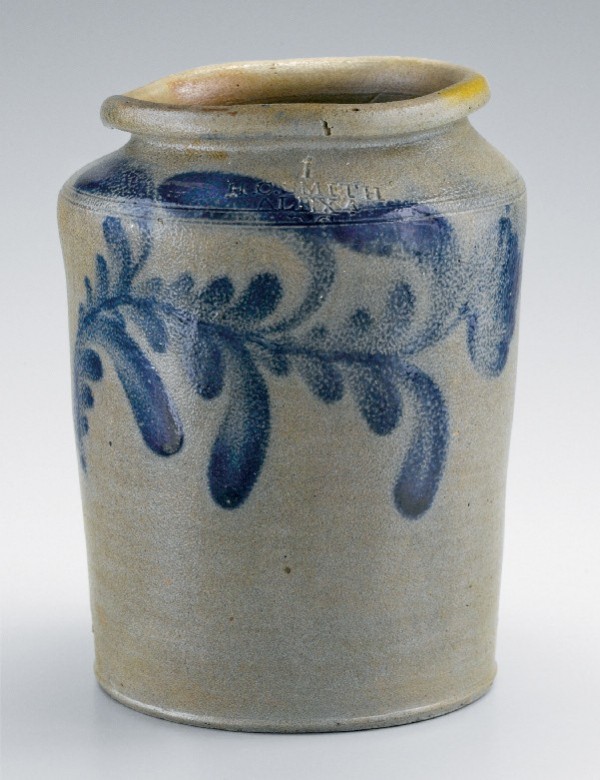
Small-mouthed jar, Alexandria, Virginia, 1831–1847. Salt-glazed stoneware, brushed cobalt. H. 9". Capacity: 1 gallon. Impressed mark: H.C.SMITH / ALEXA. / D.C (Private collection.) The shape of this jar, with a sharply angled shoulder and narrow mouth with rounded rim, is similar to that of earthenware jars made in Alexandria and Philadelphia in the late eighteenth century.

Cylindrical jar, Alexandria, Virginia, 1841–1851. Salt-glazed stoneware. H. 6 1/2". Impressed mark: H.C.SMITH / ALEXA. (Private collection.) It is likely that an 1859 Milburn trade card listing “stone fruit jars filled with cork and cement” referred to jars of this shape. The jar was probably sealed with a small stoneware lid; a cone-shaped section protrudes down through a cork ring.
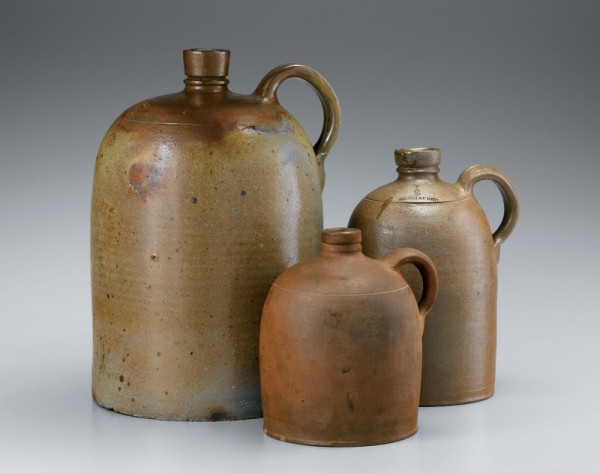
Jugs, Alexandria, Virginia. Salt-glazed stoneware. Left, 1847–1867. H. 12 1/4". Impressed mark: B.C.MILBURN / ALEXA. (Courtesy, The Lyceum: Alexandria’s History Museum.) Center, 1873–1876. H. 6 1/2". Impressed mark: W. LEWIS MILBURN. (Courtesy, The Lyceum: Alexandria’s History Museum.) Right, 1867–1873. H. 8 3/4". Impressed mark: S.C.MILBURN. (Courtesy, Smithsonian Institution, National Museum of American History.)

Pitcher, Alexandria, Virginia, 1831–1847. Salt-glazed stoneware, brushed cobalt. H. 14 1/2". Capacity: 3 gallons. Impressed mark: H.C.SMITH / ALEXA. / D.C (Courtesy, William and Jane Yeingst.)

Pitcher, Alexandria, Virginia, 1847–1861. Salt-glazed stoneware, brushed cobalt. H. 10 1/4". Capacity: 1 gallon. Impressed mark: B.C.MILBURN / ALEXA. (Courtesy, Brooklyn Museum.) The cylindrical shape of this pitcher is unusual in Alexandria, but was used in the Shenandoah Valley in the late nineteenth century.
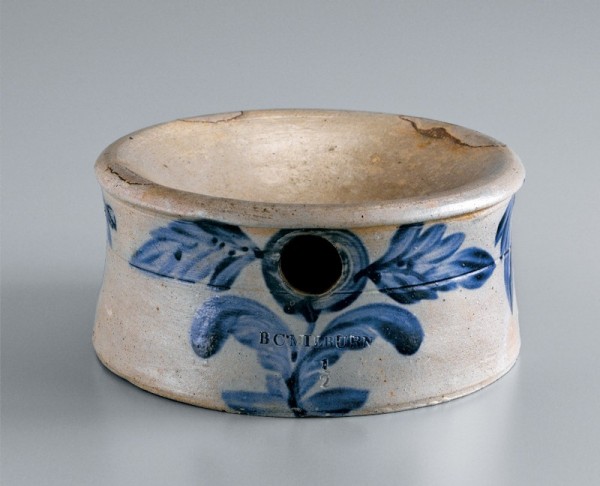
Spittoon, Alexandria, Virginia, 1847–1861. Salt-glazed stoneware, brushed cobalt. D. 7". Capacity: 1/2 gallon. Impressed mark: B C MILBURN (Private collection.)
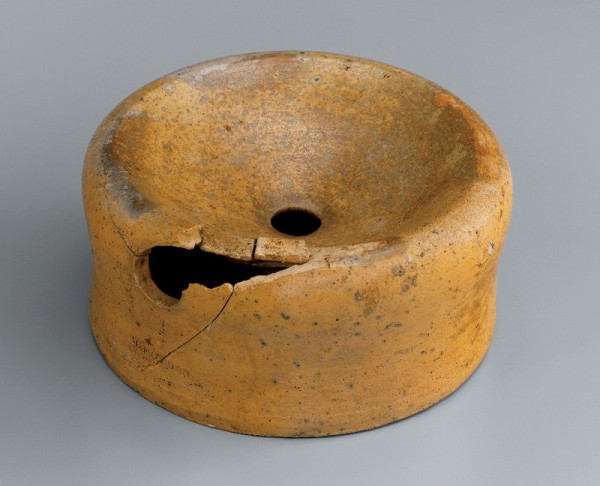
Spittoon, Alexandria, Virginia, 1841–1867. D. 7". Salt-glazed stoneware. Capacity: 1/2 gallon. Impressed mark: B.C. MILBURN. (Courtesy, Alexandria Archaeology Museum.) This spittoon was found in a privy at 524 King Street.
